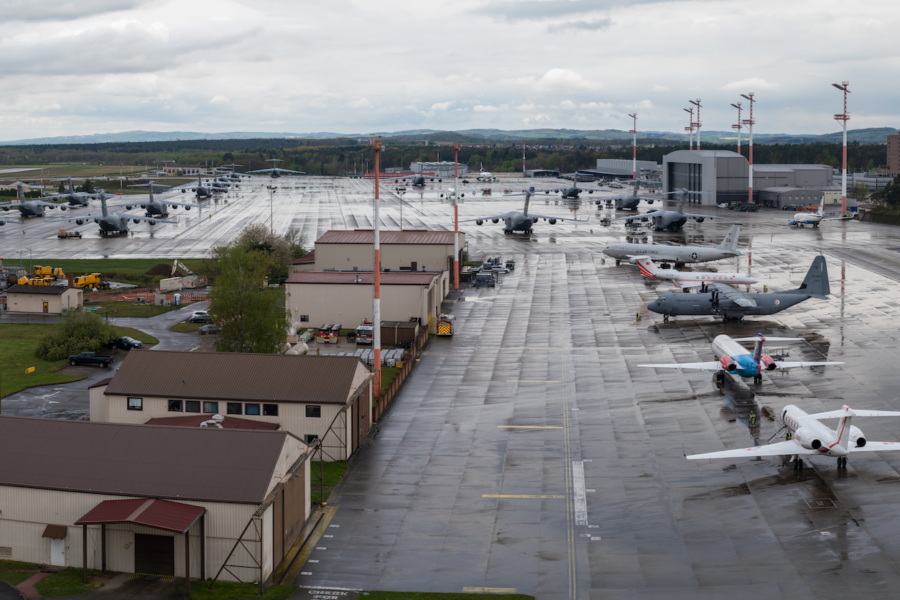RAMSTEIN AIR BASE, Germany—Within days of the Russian invasion of Ukraine, U.S. European Command stood up a 24/7 operations center to coordinate the rapid delivery of defense assistance from dozens of nations to the front line inside Ukraine.
For the first time, the Defense Department described how the EUCOM Control Center Ukraine (ECCU) works during a briefing for journalists covering the Ukraine Defense Consultative Workshop at Ramstein Air Base, Germany, on April 26, signaling a rapid evolution to changing battlefield needs.
“Quite simply, it’s a near soup-to-nuts of all things security systems [to be] delivered,” a senior defense official said of the Stuttgart, Germany-based ops center. “It’s a combination of a call center, a watch floor, meeting rooms. They execute a battle rhythm to support decision-makers as well as 24/7 engagement and coordination around the globe with about 40 to 60 people at any given time.”
Large rooms at EUCOM have been converted to the active watch floor, which tracks logistics, movements, timing flow rates, and communications with military commands such as U.S. Transportation Command.
A U.S. two-star Naval officer from EUCOM’s J-4 logistics directorate runs the ECCU with staff from 15 donor nations. Since March, it has worked in parallel with the United Kingdom’s International Donor Coordination Center (IDCC), run by a British one-star officer.
Ukrainian military liaisons also make up “fewer than five” of the ECCU staff.
“This robust, fast-evolving international effort has focused on the speed of delivery that ensures a credible, resilient, and combat-capable Ukraine military,” the defense official said.
Prior to President Joe Biden’s call for a $33 billion Ukraine supplemental security package April 28, the President had signed eight presidential drawdowns and provided $4 billion in defense aid. The ECCU worked with TRANSCOM to move each of those orders of war material from Defense Department warehouses in the United States to staging grounds in Europe and onward to NATO eastern front positions, where the material is trucked across the border into Ukraine.
Often, that has meant C-17s departing from Dover Air Force Base, Del., landing at Ramstein, and then repackaging to smaller C-130s for flights to front-line airfields. That way, the larger aircraft can quickly return to the U.S. and refill with additional defense assistance, an Air Mobility Command official told Air Force Magazine.
Initially, flights departed every other day, but the pace quickly ramped up to eight to 10 flights per day.
“At some points, it has spiked to nearly double that as we ramped up our coordination and logistics efforts to ensure that we’re meeting the needs of the Ukrainian Armed Forces in near real time,” the senior defense official said.
“Our support has also expanded from a single path via air to a multimodal effort [including] air, ground, and rail over multiple routes,” the official said. “Once it crosses that border, [the Ukrainians] have a very diverse route—paths to getting their equipment to the fight—and they clearly seem to be very effective.”
The last point has taken on outsize importance recently. Following the visits of Defense Secretary Lloyd J. Austin III and Secretary of State Antony J. Blinken by rail to Kyiv, Russia bombed supply routes, hitting five rail stations in central and western Ukraine.
Another senior defense official at Ramstein told Air Force Magazine that as of April 27, the railway attacks had not impacted the transfer of defense assistance.
Defense and humanitarian assistance is known to flow through southeastern Poland, northern Romania, and Slovakia, although apart from the Poland route, it is not public to what degree the U.S. coordinates transfer through the other NATO countries bordering Ukraine.
The ECCU official said initially there was concern the assistance would fall into the wrong hands as it is not tracked once it crosses the Ukrainian border. But force protection and operational security are “baked into the equation” and have ensured timely delivery to the battlefield.
The front line, however, has shifted to the easternmost region of Ukraine, some 800 miles from the Polish border, to the Donbas region. The most recent $800 million in U.S. defense assistance to Ukraine announced April 21 includes 72 155mm Howitzer artillery pieces and 144,000 artillery rounds, along with 72 tactical vehicles to tow the weapons.
Despite the distance, the defense official was optimistic the Howitzers would be firing on Russian targets in short order.
“If you’re not seeing Howitzers shooting in the eastern part of Ukraine within a week, then there’s a problem. But I’ll bet you’re going to see them shooting within a week,” the official said.
As Ukraine’s defense needs have shifted to long-range weapons, the official told Air Force Magazine that while air defenses such as Stingers are still “part of the mix,” they are being requested “at a lower priority level.”
The defense official pointed to the 40 nations meeting with Ukraine’s defense minister and senior military in a nearby room at the Ramstein Officer’s Club that same day, noting the constant evolution of the ECCU to respond to the perceived next phase of the war.
“Needs-based is important, but staying ahead of the problem is really important,” the official said.
“They need this aid,” the official added of Ukraine’s war effort. “There’s a lot of capacity in the Russian military, even if they’re performing badly. There’s a lot of depth there.”

